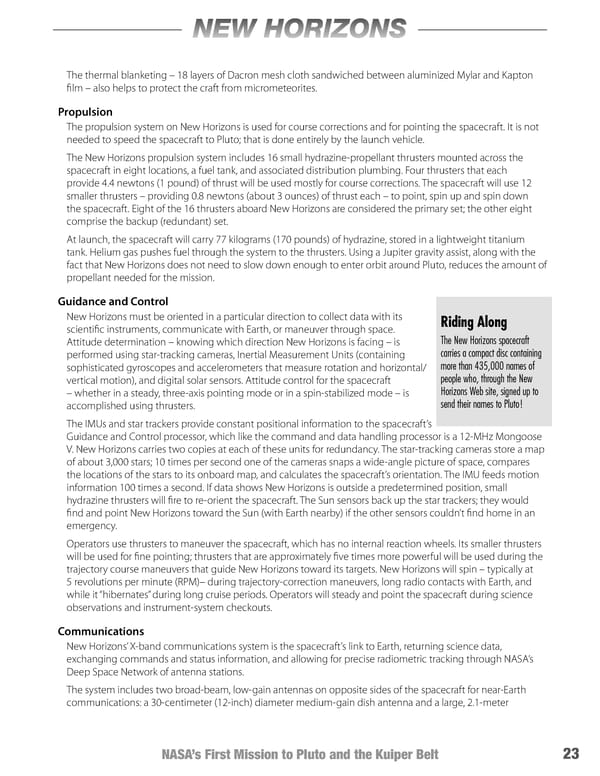NEW HORIZONS The thermal blanketing – 18 layers of Dacron mesh cloth sandwiched between aluminized Mylar and Kapton film – also helps to protect the craft from micrometeorites. Propulsion The propulsion system on New Horizons is used for course corrections and for pointing the spacecraft. It is not needed to speed the spacecraft to Pluto; that is done entirely by the launch vehicle. The New Horizons propulsion system includes 16 small hydrazine-propellant thrusters mounted across the spacecraft in eight locations, a fuel tank, and associated distribution plumbing. Four thrusters that each provide 4.4 newtons (1 pound) of thrust will be used mostly for course corrections. The spacecraft will use 12 smaller thrusters – providing 0.8 newtons (about 3 ounces) of thrust each – to point, spin up and spin down the spacecraft. Eight of the 16 thrusters aboard New Horizons are considered the primary set; the other eight comprise the backup (redundant) set. At launch, the spacecraft will carry 77 kilograms (170 pounds) of hydrazine, stored in a lightweight titanium tank. Helium gas pushes fuel through the system to the thrusters. Using a Jupiter gravity assist, along with the fact that New Horizons does not need to slow down enough to enter orbit around Pluto, reduces the amount of propellant needed for the mission. Guidance and Control New Horizons must be oriented in a particular direction to collect data with its Riding Along scientific instruments, communicate with Earth, or maneuver through space. Attitude determination – knowing which direction New Horizons is facing – is The New Horizons spacecraft performed using star-tracking cameras, Inertial Measurement Units (containing carries a compact disc containing sophisticated gyroscopes and accelerometers that measure rotation and horizontal/ more than 435,000 names of vertical motion), and digital solar sensors. Attitude control for the spacecraft people who, through the New – whether in a steady, three-axis pointing mode or in a spin-stabilized mode – is Horizons Web site, signed up to accomplished using thrusters. send their names to Pluto! The IMUs and star trackers provide constant positional information to the spacecraft’s Guidance and Control processor, which like the command and data handling processor is a 12-MHz Mongoose V. New Horizons carries two copies at each of these units for redundancy. The star-tracking cameras store a map of about 3,000 stars; 10 times per second one of the cameras snaps a wide-angle picture of space, compares the locations of the stars to its onboard map, and calculates the spacecraft’s orientation. The IMU feeds motion information 100 times a second. If data shows New Horizons is outside a predetermined position, small hydrazine thrusters will fire to re-orient the spacecraft. The Sun sensors back up the star trackers; they would find and point New Horizons toward the Sun (with Earth nearby) if the other sensors couldn’t find home in an emergency. Operators use thrusters to maneuver the spacecraft, which has no internal reaction wheels. Its smaller thrusters will be used for fine pointing; thrusters that are approximately five times more powerful will be used during the trajectory course maneuvers that guide New Horizons toward its targets. New Horizons will spin – typically at 5 revolutions per minute (RPM)– during trajectory-correction maneuvers, long radio contacts with Earth, and while it “hibernates” during long cruise periods. Operators will steady and point the spacecraft during science observations and instrument-system checkouts. Communications New Horizons’ X-band communications system is the spacecraft’s link to Earth, returning science data, exchanging commands and status information, and allowing for precise radiometric tracking through NASA’s Deep Space Network of antenna stations. The system includes two broad-beam, low-gain antennas on opposite sides of the spacecraft for near-Earth communications: a 30-centimeter (12-inch) diameter medium-gain dish antenna and a large, 2.1-meter NASA’s First Mission to Pluto and the Kuiper Belt 23
 New Horizons Page 31 Page 33
New Horizons Page 31 Page 33